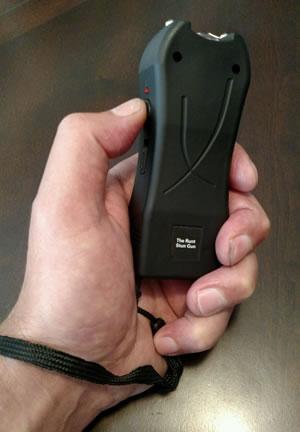Table of Contents
- Understanding Local Laws and Regulations for Carrying Self-Defense Tools
- Choosing the Right Self-Defense Tool for Personal Safety and Legal Compliance
- Proper Handling and Storage Practices to Ensure Safety and Accessibility
- Training and Preparedness Tips for Responsible Use of Self-Defense Tools
- Final Thoughts
Understanding Local Laws and Regulations for Carrying Self-Defense Tools
Before carrying any self-defense device, it’s crucial to familiarize yourself with the specific laws governing your area. Regulations can vary widely between cities, states, and countries, often detailing what items are allowed, where they can be carried, and under what conditions. For instance, certain jurisdictions may prohibit carrying knives with blades beyond a specified length, while others might restrict the possession of pepper spray or stun guns entirely. Ignorance of these laws can lead to legal complications, including fines, confiscation, or even criminal charges. Thus, diligent research and consultation with local law enforcement or legal experts can help ensure that your choice of self-defense tool remains compliant with applicable regulations.
Key factors to consider include:
- Permitted types of self-defense tools: Knowing which items are legally allowed to be carried on your person or in your vehicle.
- Carry restrictions: Some locations, such as government buildings, schools, or private properties, often prohibit certain defensive instruments regardless of general legality.
- Age and permit requirements: Certain tools might require the user to be of a specific age or possess a license to carry them.
- Transportation and storage laws: Guidelines on how to safely store or transport your self-defense equipment to avoid accidental misuse or violation of local codes.
Choosing the Right Self-Defense Tool for Personal Safety and Legal Compliance
When selecting a self-defense tool, it’s crucial to balance effectiveness with legal allowances in your area. Non-lethal options like pepper spray, personal alarms, and tactical flashlights often strike this balance well. These items are generally easier to carry discreetly and come with fewer legal restrictions compared to firearms or edged weapons. However, verifying local laws-such as permissible sizes, allowable spray concentrations, or carry restrictions-is essential before making a purchase. Opt for tools that offer quick accessibility and ease of use under stress, ensuring you can rely on them effectively during an emergency.
Equally important is understanding the proper way to carry and maintain your chosen tool to maximize both safety and compliance. For example:
- Keep tools in secure yet reachable places, like dedicated pockets or holsters designed for your specific item.
- Regularly inspect and practice using your self-defense tool to maintain confidence and functional readiness.
- Stay updated on legislative changes that could affect your ability to carry or deploy certain tools legally.
By thoughtfully choosing a tool that fits your lifestyle and local legal framework, you empower yourself with a responsible means of protection that aligns with your personal safety priorities.
Proper Handling and Storage Practices to Ensure Safety and Accessibility
When carrying self-defense tools, it’s crucial to prioritize both safety and quick access. Always opt for holsters, pouches, or cases designed specifically for your tool, as these accessories keep the item securely in place, preventing accidental discharge or injury. Make sure the storage option allows for a firm grip so you can draw the tool swiftly if needed. Further, keep your tools clean and regularly inspect them to ensure they remain functional and free from damage that might compromise their reliability. Remember that securely stored tools also reduce the risk of unintentional access by children or unauthorized individuals.
To maintain both legal compliance and ease of use, incorporate these smart habits into your routine:
- Store tools separately from firearms, unless local laws permit combined carrying methods, to avoid confusion during an emergency.
- Use locked compartments at home or in vehicles, particularly if you have visitors or family members who should not access your self-defense devices.
- Regularly review your jurisdiction’s regulations on carrying self-defense items in public places to ensure you are not inadvertently violating laws.
Training and Preparedness Tips for Responsible Use of Self-Defense Tools
To ensure you’re always prepared when carrying self-defense tools, regular practice is indispensable. Engage in hands-on training sessions, preferably under the guidance of certified instructors who can teach you how to handle your tools confidently and safely. Familiarize yourself with the legal restrictions of your area, and focus on perfecting your reaction time, grip strength, and safe deployment techniques. Incorporate simulated scenarios that mimic real-life threats; this helps improve your situational awareness and makes you more adept at using your tools only when absolutely necessary.
Equally important is developing a mindset centered around responsibility and restraint. Always treat self-defense tools as the last line of protection, not a first resort. Practice stress management and decision-making drills to maintain composure under pressure. Complement your physical training with knowledge of local laws regarding self-defense-knowing when and how to use your tools legally can protect you from serious legal consequences. Maintaining your equipment in optimal condition, including regular checks and cleaning, is another critical aspect that ensures reliability when it matters most.
Final Thoughts
Carrying self-defense tools can provide peace of mind and a greater sense of security, but it’s essential to do so responsibly and within the bounds of the law. By understanding the regulations in your area, choosing appropriate tools, and practicing safe handling, you empower yourself to protect your well-being without compromising safety or legality. Remember, the goal of self-defense is to avoid harm and escape danger-not to escalate conflict. Stay informed, stay prepared, and always prioritize safety above all.Check Our Other Blogs
- StunGun – Your Trusted Source for Stun Guns, Laws, and Self-Defense Tips
- PepperSprayLaws – Your Trusted Resource for Pepper Spray Information
- StunGunLaws – Your Trusted Guide to Stun Gun Legality and Safety



